-
Spring Planting
Order now for best selections.
-
Fall Planting
Available for preorder for fall 2025 delivery.
-
Bulk Flower Bulbs
Big savings on bulk orders!
- New
-
Gardening Resources
Flower Bulbs & Perennials at Wholesale Prices
Landscaping with Bulbs Ideas
How to Plant a Bulb Garden
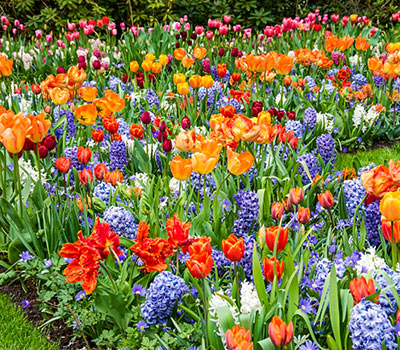
Mass Planting
To get a full Dutch-field look, plant spring bulbs in mass in loose, informal clusters. A mass planting of one variety and color delivers a big punch of visual impact. And mass-planted bulbs are easy to care for, as they have homogeneous care requirements, and the foliage matures at the same time across the group. Avoid planting in a single straight row or circle--bulbs look best planted in staggered, free-form arrangements. This spring bulb garden layout is sure to help you create a garden space full of color.
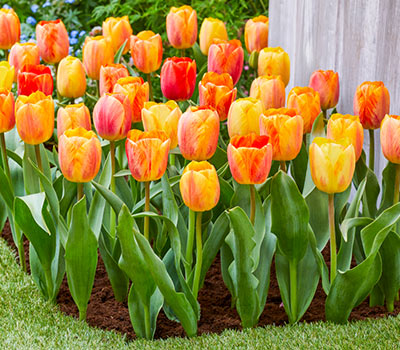
Planting in Small Spaces
When planting a bulb garden in small spaces, pick just one color. A monochromatic grouping will have greater impact and make the planting space look larger; mixed colors planted in a small space tend to make the space look smaller.
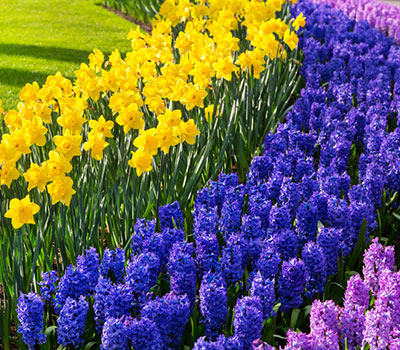
Planting in Large Spaces
If you have a lot of planting space, a planting of two or three different colors can be effective. Do not intermix them; concentrate the bulbs of each color together. Select complimentary colors, or multiple shades of one hue. White flowers can be effective in merging colors together or in brightening dark corners. Ultimately, the size of the location will determine how to plant bulbs in your landscape area.
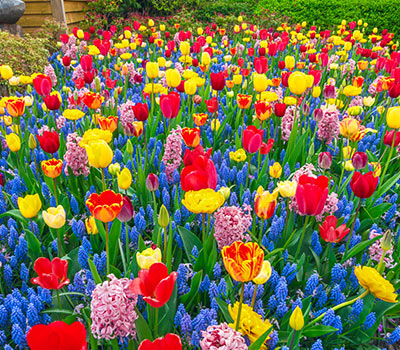
Inter-Mixing Plants
The color of spring-flowering bulbs really pops when they are planted with pansies or other compatible early flowers. Enhance the look of summer-flowering bulbs by planting them with summer flowering annuals such as impatiens, petunias, and other annuals.
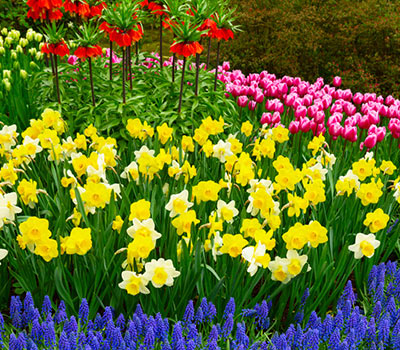
Grouping Bulbs
When planting a group of spring-flowering bulbs such as tulips, daffodils or hyacinths, use at least a dozen bulbs of one variety and color in order to increase their visual impact. Smaller bulbs, such as snow crocus, muscari and snowdrops, should be mass planted in groups of at least 50 bulbs. Blooms from smaller bulbs should be viewed up close, so they should be planted where visitors can more easily see them: next to a patio, along a sidewalk or lining a home's front walkway are examples. When planting a group of summer-flowering bulbs, such as begonias and gladiolus, 3-6 bulbs of the same variety and color are suggested.
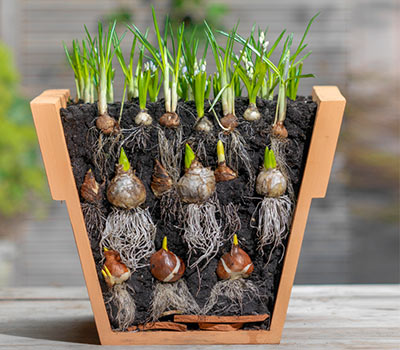
Lasagna Planting
If you can layer noodles, sauce and cheese to create a tasty lasagna--and even if you can't--you can layer bulbs to create a gorgeous lasagna garden. Whether your bulb layering is done in a container or a regular garden, the most challenging part will be determining how to best arrange your bulbs to take full advantage of their different qualities. Lasagna planting allows for waves of blooms to open over time in a broad range of colors, sizes and textures--all in a single space.
When lasagna planting in a container, use a large pot with drainage holes or fill the bottom of a hole-less container with several inches of pebbles to allow proper drainage. Add about 4 inches of potting soil on top of the pebbles, then set in a layer of bulbs using your largest variety (such as a tulip or daffodil), packed close enough so they are nearly touching. Add another 2 inches of soil, then the next set of smaller bulbs. Repeat with a third layer. Fill the pot to the top with potting soil and water well. Keep the pot in your garage, an outbuilding or another cool, dry place until early spring, when you'll want to place it in the sun. Before long, your container will be filled with wave after wave of beautiful blooms!
To use the lasagna planting method directly in the garden, simply plant the largest bulbs at their recommended depth and then layer smaller bulbs on top. For the best results, plant in well-drained, loamy soil that can easily be dug up to 12" deep, which should be enough for three layers.
| Shop All Flower Bulbs |
| See More Tips |
Have another question? Return to the Customer Service Help page or send an e-mail directly to Customer Service
Copyright © 2025 Gardens Alive!, Inc. d/b/a Dutchbulbs.com. All Rights Reserved. Dutchbulbs.com trademarks are registered trademarks of Gardens Alive!, Inc.
This site is protected by reCAPTCHA and Google Privacy Policy and Terms apply.
This site is protected by reCAPTCHA and Google Privacy Policy and Terms apply.

Item added to cart





